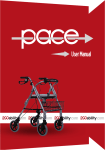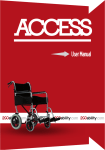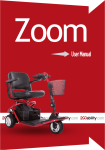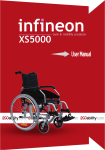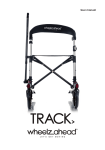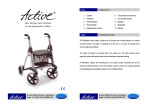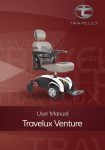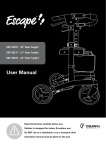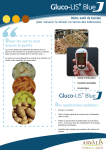Download User Manual - Scoota Mart
Transcript
User Manual YOU AND / OR YOUR ATTENDANT MUST READ AND FULLY UNDERSTAND THIS MANUAL BEFORE USE General information You have just purchased a 2GOability rollator and we want to thank you for the confidence in our 2GOability products. The rollator is a quality product. The policy of 2GOability is to continually improve the quality and reliability of our products. We reserve the right, therefore without prior notification, to alter this guide. It is important that your guide for the use of the rollator is read carefully. The manual contains important information about the safe use and maintenance of your rollator. We recommend that you keep this guide, it is also your proof of warranty and you will find it useful for referring to it at a later date. The safety instructions in this guide are general guidelines that must be seen as broad guidelines. Your new rollator requires frequent maintenance, much of which you can do yourself. Caution! In this guide you will find information and warnings. These are clearly identified by the symbols below and the appearance of the text: Tip Information Warning To avoid personal injury, warnings must be followed 1 Fill out the information on your authorized dealer below: Company: ………………………………………………………………… Address: ………………………………………………………………… ………………………………………………………………… Telephone number: ………………………………………………………………… Fax number: ………………………………………………………………… Email address: ………………………………………………………………… Website: ………………………………………………………………… 2 1 IDENTIFICATION ....................................................................................... 4 2 GENERAL EXPLANATION CONCERNING YOUR ROLLATOR ...................... 5 2.1 Components of the rollator ............................................................................5 2.2 General explanation of the function and possibilities of your rollator..................5 3 SAFETY REGULATIONS .............................................................................. 6 3.1 General safety regulations .............................................................................6 3.2 Warnings for safe use ...................................................................................6 4 INSTRUCTIONS FOR USE .......................................................................... 7 4.1 Walking with your rollator .............................................................................7 4.2 Confronting pavements and unequal surfaces .................................................7 5 INSTRUCTIONS FOR USE AND MOUNTING OPTIONS .............................. 9 5.1 5.2 5.3 5.4 5.5 5.6 5.7 5.8 Technical information ...................................................................................9 Unfolding and folding the rollator ...................................................................9 Carrying the rollator ................................................................................... 11 Using the brakes ........................................................................................ 11 Using the seat ............................................................................................ 12 Using the stepper ....................................................................................... 12 Setting the height of the push handels ......................................................... 13 Placing and removing the shopping bag ....................................................... 13 6 TRANSPORT AND TRANSIT IN CAR ........................................................ 14 7 MAINTAINANCE ....................................................................................... 14 8 PROBLEM ANALYSIS AND SOLUTIONS ................................................... 15 9 WARRANTY .............................................................................................. 15 9.1 Warranty application ................................................................................... 15 9.2 Warranty definition ..................................................................................... 15 10 GENERAL MAINTENANCE INSTRUCTIONS .......................................... 17 3 1 IDENTIFICATION Your rollator is equipped with a unique identification number. You can find this number on the frame of your rollator. Below is an example of the frame label on which you can find the identification number. Furthermore you will find the explanation of the various data stored on the frame label listed below. 2 5 1 6 6 3 4 7 7 1. Production date Production date of the rollator 2. Serial number The unique identification number. You must have this number when making technical requests or if warranty parts are required. 3. Maximum user weight The largest occupant weight allowed for protection of both the rollator and the user. 4. Type number This number indicates which model of rollator you have, again this is always required when making technical calls. 5. Model name The model name of your rollator. 6. Usage application Where you can use your rollator. 7. Warranty This is the warranty period. Chapter 9 describes your warranty terms and conditions in more detail. 4 2 GENERAL EXPLANATION CONCERNING YOUR ROLLATOR 2.1 Components of the rollator 1 17 2 3 13 4 12 5 11 6 10 7 1 2 3 4 5 6 7 8 Push handle Seat Brake lever Adjustment lever for push handles Side frame Rear wheel Stepper 9 8 9 10 11 12 13 Front wheel Front fork Ball head Shopping bag Lifting handle Brake cable Your rollator is equipped with a number of elements and parts. You should know these before continue reading this manual. Designs and specifications may change without prior notice. 2.2 General explanation of the function and possibilities of your rollator The rollator is designed for indoor and outdoor use. The rollator is equipped with multifunction brakes and stable wheels which roll easily. The rollator is especially developed so that it can be adjust to every individual user. Your rollator is a medical equipment product and is not a standard consumer product. You must follow this manual completely to ensure good, optimal and safe use of your rollator. 5 3 SAFETY REGULATIONS 2GOability specifically disclaims responsibility for any body injury or property damage which may occur during any use which does not comply with laws or ordinances. If used correctly, the 2GOability rollator is an utmost safe and stable product, if the instructions for use as described in this manual are followed. However, it is possible when the 2GOability rollator is not used correctly, dangerous situations may occur. 3.1 General safety regulations Protect your 2GOability rollator by checking it regularly. When a part of your rollator is not functioning properly, a dangerous situation could occur. Warning: You must keep your rollator in a good state to guarantee safe use. 3.2 Warnings for safe use Warnings: Avoid using your rollator on roads. Use pavements if possible; Do not use your rollator in sand, rough area, wet and slippery surfaces or surfaces with little grip; Do not drive into curbs; Never connect anything to the wheels; Engage the brakes when you are in or on a lift and when you want to get off; The maximum weight capacity has been indicated on your rollator frame label; Unauthorized modification and or use of parts not supplied by 2GOability will invalidate the warranty of this rollator and may lead to injury to the user and or damage to the rollator; Do not push the rollator to far in front of you, this can cause falls and incorrect positions; Before using your rollator, always check if the brakes are working perfectly; When unfolding the rollator, check if the folding mechanism is locked into place; Use the parking brake if you are stopping or parking; Make sure that your rollator is adjusted to the correct height to avoid incorrect positions and falls; When folding and unfolding the rollator be aware that you do not get stuck with your fingers between moving parts. This may cause injury; 6 Do not use the rollator for transporting people or heavy loads; Do not let children play with your rollator; Do not use the rollator when the brakes are not working; The rollator is not intended to be self-propelled while seated; All wheels must be in contact with the floor at all times during use. This will ensure the rollator is properly balanced. The brakes must be in the locked position before using the seat; Do not use your rollator when it is damaged or has any malfunction. 4 INSTRUCTIONS FOR USE This rollator is designed for people with reduced walking distance, with balance disturbances or other disabilities which prevent people to have a normal standing posture. The use of the rollator will help people improve their mobility. 4.1 Walking with your rollator When you are walking with your rollator make sure that you walk fully upright, with the rollator near your body, see figure 1. This is for the best support and the safest movements. If you follow this order for movement with your rollator you will have the correct body position. Figure 1 7 4.2 Confronting pavements and unequal surfaces Warning: Do not drive into curbs! Inspect the slope always for risks, such as holes or slippery and uneven surfaces before you walk further. Going up the pavement: When you want to go up a pavement you should do this in the following manner; 1. Step with your foot on the stepper, see paragraph 5.6, to tip up the front wheels; 2. You can roll your wheelchair forwards; 3. When the front wheels are above the pavement you can let the rollator down; 4. Now you can push the rollator forwards and place the rear wheels on the pavement. Going down the pavement: 1. Step with your foot on the stepper to tip up the front wheels; 2. Carefully roll the rollator forwards; 3. When the front wheels are off the pavement you can let the rollator down; 4. Now you can push the rollator forwards and place the rear wheels back onto the ground. 8 MAKING ADJUSTMENTS TO YOUR ROLLATOR CAN CAUSE BIG RISKS FOR YOUR SAFETY AND THE FUNCTION OF YOUR ROLLATOR. ADJUSTMENTS MADE BY YOURSELF ARE STRONGLY ADVISED AGAINST AND CARRIED OUT AT YOUR OWN RISK. 5 INSTRUCTIONS FOR USE AND MOUNTING OPTIONS In this chapter we will explore all the possibilities on your rollator. Your rollator is a 2GOability Move 5.1 Technical information 2GOability Move Total height (surface to top) Total length Total width Width between push handles Seat height (surface to seat) Height folded Length folded Width folded Maximum user weight 82 cm – 104 cm adjustable 70 cm 60 cm 42 cm 63 cm 82 cm – 106 cm adjustable 70 cm 29 cm 125 kg 9 5.2 Unfolding and folding the rollator Your rollator can be folded. In this way you can easily carry and transport your rollator. In folded position the rollator stays in standing position and therefore also be used for support when it is folded. Warning: When folding or unfolding the rollator be aware of the danger of trapping injuries! Unfolding the rollator Make sure you stand behind the rollator; Grab both seat tubes and move them apart; Push both seat tubes downwards so that the rollator will unfold, when you hear a click the rollator is completely unfolded, see picture 1. Picture 1 Folding the rollator Make sure you stand behind the rollator; Pull the strap upwards to fold the rollator, see picture 2. Picture 2 10 5.3 Carrying the rollator When the rollator is folded you can carry the rollator by using the lifting handles, see picture 3; Picture 3 5.4 Using the brakes Your rollator has two kinds of brakes. The driving brake and the parking brake. Driving brake When you need to slow down speed while pushing the rollator, you have to squeeze the brake lever to reduce your speed, see picture 4; Be aware that you do not push the rollator while squeezing the brake lever. If you do attempt to do this, this will cause damage on the tyres and the brakes, which will result in damaged brakes; As mentioned earlier in paragraph 3.2, do not use the rollator if the brakes are defect! Picture 4 11 Parking brake Push the brake lever downwards to engage the parking brake, see picture 5, you will hear a click that will confirm that the parking brake is engaged; Squeeze to remove the parking brake, this will be confirmed when you hear a click. Picture 5 5.5 Using the seat Check if the parking brake is on, before you take a seat on the rollator; Make sure you sit with your back towards the direction of travel. 5.6 Using the stepper As mentioned before in the manual, there is a so called stepper on your rollator. The stepper is designed for confronting obstacles. Step with your foot on the stepper, see picture 6; This will cause a leverage effect, the front wheels will be tipped up. Picture 6 12 5.7 Setting the height of the push handels You can adjust the height of the push handles for optimal use of your rollator. Pull the black lever at the back of the rollator, see picture 8; Pull or push the push handle to the desired height; Release the black lever. If you are still able to move the push handle, move it until you hear a click. This will confirm that the push handle is locked. Picture 8 5.8 Placing and removing the shopping bag Placing the shopping bag Grab the clip and push it on the lifting handle, see picture 9. Picture 9 13 Removing the shopping bag Pull the clip off the lifting handle, see picture 10. Picture 10 6 TRANSPORT AND TRANSIT IN CAR Your 2GOability rollator is designed to be easily transported by car. With the lifting handles you can easily carry your rollator in or out of the vehicle. 7 MAINTAINANCE It is important to clean your rollator regularly. Clean the frame. You should wash the frame regularly with warm soapy water; Clean the brakes blokes and springs regularly; Clean the basket; Dry the rollator after cleaning. Also dry your rollator after you have been, for example, in a rainstorm. 14 8 PROBLEM ANALYSIS AND SOLUTIONS Your 2GOability rollator is inspected and adjusted so that you can use it immediately. Continual use necessitates maintenance, especially if the factory set adjustments have been altered. The following troubleshooting guide lists several common problems that may occur and offers corrective actions for each. Malfunction Wheels are not turning properly Parking brake doesn`t work Possible cause Wheels are dirty Solution Cleaning the wheels The mechanical brakes Retailers for repair work to heavy The brake is bent Tires are worn up 9 Retailers for replacement WARRANTY 9.1 Warranty application Together with your rollator you get the factory warranty. This warranty is only granted to you as the consumer. It is not intended to be used commercially (like hiring or institutional use). The warranty is limited to defects to materials and possible hidden shortages. 2GOability offers a warranty period of 1 year. Also you can find the warranty periods label on the frame of your rollator. See also chapter 1. Tip We recommend the use of only 2GOability replacement parts. If you do not use original parts, the warranty will be expired. 9.2 Warranty definition Your manual is also the warranty form, fill in the relevant details on page 2 and store it carefully. Warranty conditions The warranty period commences upon the date of purchase. If within the warranty period, your rollator will be defect, it will be repaired or replaced. However you do need to provide to 2GOability a complete filled in warranty registration form, a copy of the bill with the date of purchase and the original packaging. 15 Tip Warranty is not transferrable. For more information and the location of service agents please visit our website: www.2GOability.com This warranty does not include any labour charges incurred by replacements. Under normal circumstances no responsibility is accepted when the rollator needs replacement or repairs as a direct result from: Not maintaining the rollator and parts according to the recommendations of the manufacturer, or not using the specific original parts; Damaging the rollator or parts by inattentive use, accident or wrong use; Adjusting the rollator or parts, different from the specifications of the manufacturer, or reparations done before the service agent is warned. If the product is not equipped with an original factory frame number and identification label as described in the manual, see chapter 1. The rollator that is described and showed in this manual can differ from your own model in details. However, all instructions are relevant, independent of slightly different details. We reserve the right to change the product in this manual without further notice. All drawings, measures and capacities showed in this manual, are approximations and may be slightly different to your rollator specifications. Warning: 2GOability can not be liable for any consequent or individual damage whatsoever. While this manual is created with care it is not exclusive. The warranty is only valid during the indicated period. If adjustments are made to the rollator, which have structural impact on the product, the warranty will expire completely. You can visit www.2GOability.com for an enlarged warranty and supply conditions and an address list of service agents. 16 10 GENERAL MAINTENANCE INSTRUCTIONS Your rollator needs periodical maintenance. A badly maintained rollator will give more technical problems, turn less flexible and fall out the warranty terms. Preventive maintenance is most important and many of these things you can easily do yourself or a friend or family member can help you. We highlight below the maintenance you can do yourself. Inspection Working of the brake Checking the reversibility of front wheels Cleaning Checking the stability of the frame Oiling the wheel bearing Daily X X Monthly Yearly X Done by User User X User Retailers X Retailers Tip The 2GOability Move complies with EN 12182 and ISO 11199-2. For more information, please visit our website, www.2GOability.com 17 18 2GOability.com: ‘Créateur de solutions de mobilité’ France: UK/Ireland: Belgium: Germany: Spain: Poland: Netherlands: [email protected] [email protected] [email protected] [email protected] [email protected] [email protected] [email protected] European distribution centre: 1, Route d’Anrosey, Laferté sur Amance 52500 Haute-Marne France




















